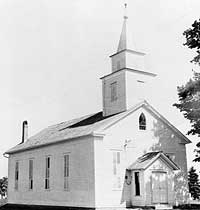History of the Augustana Lutheran Church
 In 1845, five families from Sweden settled in Jefferson County in Eastern Iowa and founded a community they first called "Stockholm" and later "New Sweden". In 1848, they persuaded a layman, M.F. Hokanson, to become their pastor. Thus, the birth of a new church in a new land. This was followed by the gathering of Scandinavian immigrants and the formation of congregations, served by pastors primarily trained in Sweden, in a number of midwestern communities.
In 1845, five families from Sweden settled in Jefferson County in Eastern Iowa and founded a community they first called "Stockholm" and later "New Sweden". In 1848, they persuaded a layman, M.F. Hokanson, to become their pastor. Thus, the birth of a new church in a new land. This was followed by the gathering of Scandinavian immigrants and the formation of congregations, served by pastors primarily trained in Sweden, in a number of midwestern communities.
The organizing meeting of the Augustana Synod was held at Jefferson Prairie, Clinton, Wisconsin, June 5-8, 1860. Twenty-seven pastors and thirteen laymen represented 49 congregations with 4,967 communicants. The Rev. T.N. Hasselquist was elected president and the chosen name "Augustana", suggested by Rev. Eric Norelius, who was to become the third president, indicated the confessional stand of the new Synod.
 In the month that preceded the organization of the Augustana Synod, Abraham Lincoln had been nominated for the presidency of the United States and before the end of the first year of Augustana's existence as a church body, Lincoln had been elected President and the Confederate States of America had been launched. This new church body (later to be known as the Augustana Lutheran Church) came into being in a divided country on the threshold of a Civil War.
In the month that preceded the organization of the Augustana Synod, Abraham Lincoln had been nominated for the presidency of the United States and before the end of the first year of Augustana's existence as a church body, Lincoln had been elected President and the Confederate States of America had been launched. This new church body (later to be known as the Augustana Lutheran Church) came into being in a divided country on the threshold of a Civil War.
The Augustana Lutheran Church that came into being in 1860 ended as a corporate body in 1962 when it joined with three other church bodies by the act of consolidation to form the Lutheran Church in America.
During its 102 year history, Augustana evolved into a national church body that was mission and service oriented as it (1) enhanced the ministry of the congregations by providing services to them, (2) extended the mission of the church by sending missionaries to various areas of the country and overseas, (3) expanded the horizons of the congregational members by relating to other church bodies, (4) evidenced the social concern of the church by establishing social service agencies/institutions and (5) ensured the education of its members and leaders by establishing academies, colleges and a seminary.
From its small beginning, Augustana grew to include 423,673 communicants in 1,269 congregations (organized into thirteen conferences) served by 1,393 ordained ministers.
At the time of the consolidation that formed the Lutheran Church in America in 1962, Augustana evidenced:
- Its commitment to be a church and serve its congregations with an administrative structure that included an Executive Council with numerous committees, bureaus, commissions, boards and auxiliaries.
- its commitment to outreach by supporting 193 missionaries serving overseas and 6 serving as home missionaries, and had 15 of its ordained ministers serving as military chaplains, 15 serving Veterans Administration Hospitals and 5 serving Federal Prisons.
- its commitment to ecumenical relationships by holding membership in the National Lutheran Council, the Canadian Lutheran Council, the Lutheran World Federation, the National Council of Churches, the World Council of Churches and the American Bible Society.
- its commitment to social concerns and education by relating to 23 Homes for the Aged, 13 Hospital and Related Facilities, 7 Hospices Seamen's and Rest Homes, 10 Children's Homes, 6 Educational Institutions and 1 Publishing House.
In discussions relative to Lutheran cooperation and unity, Augustana played a significant part. In 1956, the annual convention voted to affirm a joint invitation by it and the United Lutheran Church in America to all Lutheran church bodies in North America to "consider such organic union as will give real evidence of our unity in the faith". This action led to the historic day of June 28, 1962, when at Cobo Hall in Detroit, Michigan, the convention delegates together with delegates from the United Lutheran Church in America, the American Evangelical Lutheran Church and the Suomi Synod (Finnish Evangelical Lutheran Church) formed the Lutheran Church in America, ending the corporate existence of the 102 year-old Augustana Lutheran Church.